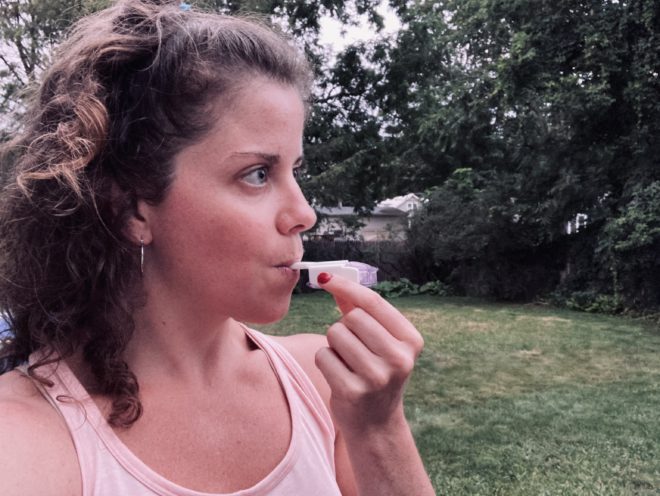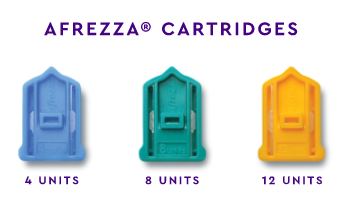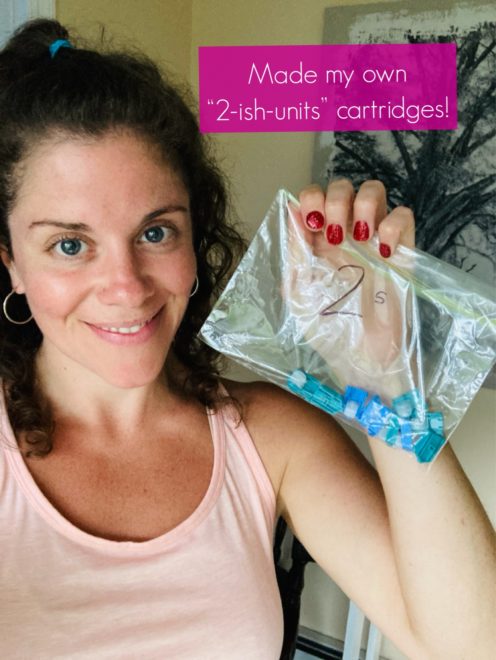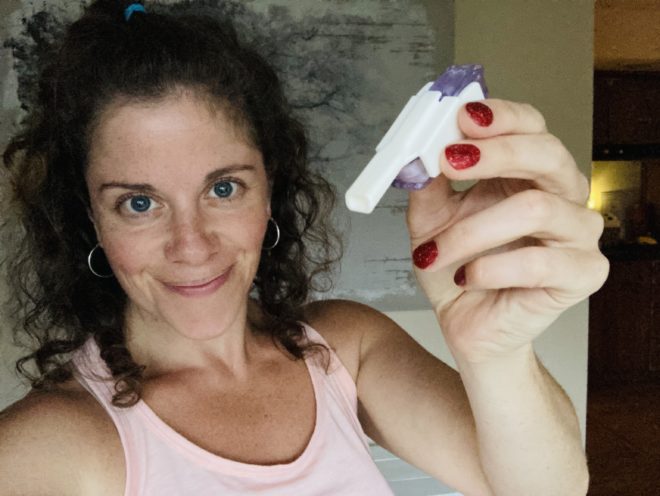Putting Inhaled Insulin to the Test
Editor’s Note: This article is about Ginger’s personal experience using Afrezza, and what has worked for her may not work for everyone. Please consult your health care team before making any changes to your diabetes care regimen. Beyond Type 1 has an active partnership with MannKind, makers of Afrezza. This article was not produced as part of that partnership, and the company had no input into its creation.
Disclaimer: This story is about a person with type 1 diabetes using Afrezza. Much of this person’s experience using Afrezza could apply to the experience with type 2 diabetes. At the time of publication, we were still looking for people with type 2 diabetes to share their experience using Afrezza. If you have type 2 diabetes and would like to share your story, please contact us at hello@beyondtype2.org.
I’ve lived with type 1 diabetes for over 23 years. Using long-acting and rapid-acting insulins (and about a decade on an insulin pump), I’ve taken approximately 45,000 injections. After years of hearing friends in the diabetes community talk about using inhaled insulin, I finally gave it my full attention over the last month.
Here, I share as much detail as possible about my experience using Afrezza inhaled insulin for my mealtime and correction doses of insulin.
SPOILER ALERT: I am loving Afrezza!
- It’s wicked fast—faster than I thought possible. I never dose until I’m done eating.
- It makes preventing lows around exercise so much easier.
- Once you learn how to dose it, the mild lows nearly correct themselves because it clears your system so quickly.
- When correcting mild-to-severely high blood sugars, you’re in your goal range within 30 to 60 minutes because it’s so fast.
- You don’t get the food cravings that come with injected rapid-acting insulin!
- It’s amazingly fun to take insulin without stabbing my body multiple times a day with a syringe!
First, learn the basics of inhaled insulin here:
- All About Inhaled Insulin
- Afrezza Inhaled Insulin (DiabetesMine)
Starting Afrezza: You’ll need patience and an open mind
I’ve had 23 years to learn how to manage my diabetes with injected insulin, so I shouldn’t expect the switch to Afrezza to be an instantaneous success in just a few days.
 The first time I tried using inhaled insulin—a couple years ago—I was in the middle of a divorce, moving and selling my house. Not a great time to try a completely different form of insulin! I’d gotten a pack of freebies from a friend who had plenty to spare. A temporary experiment, I was not giving it my full attention or the ability to see its full potential. I was also doing a lot of things wrong with it—like frequently overlapping it with injected Novolog and then crashing low.
The first time I tried using inhaled insulin—a couple years ago—I was in the middle of a divorce, moving and selling my house. Not a great time to try a completely different form of insulin! I’d gotten a pack of freebies from a friend who had plenty to spare. A temporary experiment, I was not giving it my full attention or the ability to see its full potential. I was also doing a lot of things wrong with it—like frequently overlapping it with injected Novolog and then crashing low.
This time, though, I gave it my all, with far more patience for the learning curve. Taking careful notes and creating careful experiments, I’ve found that Afrezza is an awesome method of getting most of my mealtime and correction doses of insulin, with significantly less effort to prevent lows, no syringes puncturing my skin, and a greatly appreciate change of pace in a disease that ain’t going away anytime soon.
Actually getting Afrezza
I’m grateful my primary care doctor immediately said yes to prescribing me Afrezza. (And my insurance approved it, too!) But keep in mind: how you go about filling your prescription for Afrezza can play a big role in getting coverage or not. Here’s what I learned in the process:
- If you have health insurance: First, remember when asking your doctor to write a prescription for Afrezza to have it sent to the pharmacy MannKind works closely with:
- UBC Pharmacy LLC
4700 N Hanley Rd Ste B
Saint Louis, MO 63134
NPI: 1962978858
Fax: 866-750-9260
Phone: 844-323-7399 - When your doctor sends the prescription to this pharmacy, the Afrezza patient advocacy team will battle your insurance for approval while also supplying you with inhaled insulin in the meantime. The insurance battle could take at least three months, so Afrezza is really trying to put the patient first by getting you access to the insulin you need during this process.
- They need to hear reasons why your “current method of diabetes management” isn’t working. (As if the reason “I don’t want to take six injections every day” isn’t enough.) Afrezza will help your doctor express your need for Afrezza if you have the prescription sent to the UBC pharmacy described above.
- If you do get insurance approval, be sure to register for a co-pay savings card!
- UBC Pharmacy LLC
- If you are denied coverage or don’t have health insurance: Check out the patient assistance program offering Afrezza for $99/month. But don’t take your health insurance’s first denial without fighting back! Appeal, appeal, appeal. Again, they need to hear reasons why your “current method of diabetes management” isn’t working.
Afrezza doses vs. injected rapid-acting insulin
Here is the general conversion of an injected insulin dose to an inhaled Afrezza insulin dose. It’s important to experiment carefully when you begin using Afrezza to determine how much a 4-unit cartridge affects you, and so on.
While you’re used to dosing exactly the number of units you need with injected insulin, Afrezza is different. The dosages are more generalized and do not require the same precise dosing approach as injected insulin.
Most people do find that they need more units in Afrezza than their rapid-acting injected doses. I have also found this to be true, using approximately one and a half times more Afrezza units than injected insulin to keep my blood sugars in my goal range. It’s not a perfect 1:1 conversion.
| Afrezza insulin cartridge | Insulin |
| 4-unit cartridge (blue) | Up to 4 units |
| 8-unit cartridge (green/teal) | 5 to 8 units |
| 12-unit cartridge (yellow/orange) | 12 units |
As you’ll read later in my experience using Afrezza, I learned how to “hack” the cartridges and create my own 2-unit cartridges to correct mild lows and dose for low-carb meals.
Tips for Week One with Afrezza inhaled insulin
- Wear a continuous glucose monitor (CGM) (if possible) You’ll want to be able to see the action time, when to take your dose during/after eating, and when to take a follow-up dose for certain meals. Having easy access to your blood sugar level is essential because Afrezza acts so darn fast. Timing it with the moment your blood sugar starts to rise is really, really helpful and important.
 Treat it like a new medicine, not like your injected insulin. Start with a brand new mindset because this is a very different approach to managing blood sugars. The timing, dosing, effect and duration are totally different from what you’ve been doing for years or decades.
Treat it like a new medicine, not like your injected insulin. Start with a brand new mindset because this is a very different approach to managing blood sugars. The timing, dosing, effect and duration are totally different from what you’ve been doing for years or decades.- With support from your healthcare team, you should expect to increase your basal/background insulin dose anywhere from 10 to 20 percent. I ended up increasing my Lantus dose from 8 or 9 units to 11 units. I wasn’t told to do this until a few days after I’d started, but it was obvious on day 1 that I needed more Lantus to compensate for the lack of Novolog being in my system for four hours after every meal. While we often think of rapid-acting insulin as simply covering our food, the four to five hour duration of Novolog and Humalog absolutely covers some of your background needs, too. (I did work my way up to 12 units, but it was clear after a few days and several lows that 12 was too much.)
- Keep your chin level or tilted slightly downwards when you inhale. I didn’t know this the first time I tried Afrezza, and I coughed a lot when instinctively tilting my chin up while inhaling. After getting this chin tip from Jennifer Okemah, CDCES, RD, I found inhaling was easier and I’ve experienced zero coughing. She also recommends taking a sip of water before and after each inhalation.
- Expect to need a follow-up dose for larger or high-protein meals. Most of my meals are about 400 to 500 calories, eating every three to four hours. I don’t need a follow-up dose for these meals. However, for those slower digesting meals—like my protein shake—I definitely need a 4-unit cartridge when eating and another 4-unit cartridge one and a half hours later. Trial and error. Take good notes!
- Do not pre-bolus! In fact, don’t even take your Afrezza when you start eating or halfway through your meal. It works so fast. So fast that you should usually take it after you’ve finished eating. Learning this timing is much easier if you’re wearing a CGM or flash blood glucose monitor (FBGM) to watch for the slight rise of your meal digesting, then take your Afrezza.
- Give yourself at least a week of using just Afrezza for your mealtime/correction doses, then determine where you might still need to use injected rapid-acting insulin (Novolog, Humalog, Fiasp, etc.) for situations like micro-doses or really slow-digesting meals (pizza) right before bed when you don’t want to wake up to inhale a follow-up dose.
- When using both injected rapid-acting (Novolog or Humalog, etc.) and Afrezza, be very, very careful about overlapping. Ideally, you’ll use as little injected rapid-acting as possible to minimize this easy cause of lows.
- Overall, give yourself a good month to learn how to use Afrezza. Getting used to how fast it works, how much you need to correct varying high blood sugar levels, and how quickly it’s out of your system takes a lot of trial and error.
My favorite things about Afrezza inhaled insulin
- It acts fast. Wicked fast. Within 20 minutes of taking a dose to correct a high or impact a meal, I see it working on my blood sugar. It’s wildly wonderful and so satisfying!
- Because it acts so fast…I learned within the first two weeks that I absolutely do not need to take my dose halfway through eating—even when testing super starchy foods like rice. It’s awesome to watch your blood sugar rising, then suddenly flatten and stay in range after eating. Fast. Fast. Fast. EXAMPLE: The few times I’ve really needed an 8-unit cartridge includes the night I treated myself to one and a half homemade gluten-free grilled cheese sandwiches. Lots of carbs. Lots of fat. I was 4.4 mmol/l80 mg/dL at the start of the meal, and I’d already learned not to dose too early, especially with a high-fat meal. About 30 minutes after eating, I checked my CGM. Ooops! I was already up to 7.6 mmol/l138 mg/dL with an UP arrow. I inhaled the 8-unit cartridge. 45 minutes later, I was 6.2 mmol/L112 mg/dL with a slanted DOWN arrow. 90 minutes after inhaling, I was at 6.1 mmol/l110 mg/dL, steady.
- It’s out fast. While their FDA-approved language says it’s out within “one and a half to three hours depending on the dose,” I’ve found that the 4-unit dose is totally out of my system within one and a half hours.
- It’s very easy to stay under 8.8 mmol/l160 mg/dL with Afrezza once you get a knack for timing your dose, because it acts so fast. You can easily stop rising blood sugars in their tracks if you underestimate the carbohydrates in a meal. Yes, you can experience spikes if you underestimate the dose, but you learn quickly what kinds of meals need a 4-unit cartridge or an 8-unit, or a follow-up dose. And you can stop the spikes so quickly, too, so it’s not like spiking when you’re using Novolog or Humalog.
- The lows I experienced while fine-tuning my doses come with far less hunger. Since Afrezza is out of your system so fast, the low blood sugars feel mostly mild, and often recover on their own, with a 3.6 mmol/L65 mg/dL or 3.9 mmol/L70 mg/dL rising to 5.5 mmol/l100 mg/dL once it’s fully out of your system. (Exceptions to this might be if you went for a jog right after taking Afrezza. I regret that experiment, LOL. Or if you took an 8-unit cartridge when you only needed a 4-unit cartridge.)
- The hunger cravings that come with lows from injected insulin don’t happen with Afrezza. Because the insulin clears your system so quickly so the low isn’t plummeting for 30 minutes, you don’t feel as awful, and you’re not feeding as much insulin because it’s not in your system as long.
- I’ve also found the lows need very little treatment—like, less than 5 grams of carbs. We’re so used to correcting lows with 15 grams of carbs because rapid-acting insulin is onboard for four hours, the low lasts much longer. When you’re treating a low and the insulin is totally out of your system at the same time the low hits, you need very little to get back above 3.8 mmol/l70 mg/dL. Treating any low with more than 3 to 5 grams of carbs sent me up over 7.2 mmol/l130 mg/dL or 8.3 mmol/L150 mg/dL nearly every time, demonstrating that I barely needed to treat the low.
- The overall risk of lows is lower because you don’t need to exactly match your carbs. A 4-unit cartridge covers my typical meals of 30 grams of carbs (veggies + protein or fruit + fats). While we’re all used to micromanaging out carbs + insulin, Afrezza makes it more of a general dosing strategy, and it mostly works. It’s hard to explain, but you simply don’t need to match carbs to insulin as precisely as with Afrezza. Exceptions, however, are with low-carb meals—more on this later.
- The overall risk of lows around exercise is lower because it’s out of your system so fast. If I ate lunch at 12 p.m., took Novolog, and tried to walk my dog at 1 pm, I’d plummet because the Novolog is at its full effect and going to be onboard for another several hours. With Afrezza, I could eat a meal at 12 p.m., take a 4-unit cartridge, and walk at 1 pm without eating extra carbs to prevent lows because the inhaled insulin has already peaked and all that remains is the last 30-minute tail.
- I’ve learned that most of my meals need only the 4-unit cartridge. I eat a lowish-to-moderate carb diet, with about 30-grams of high-fiber whole food carbs at every meal. The only time I’ll use an 8-unit cartridge of Afrezza is for more indulgent treats, like this week’s homemade blueberry crumble, and the follow-up dose about 90 minutes later still only called for a 4-unit cartridge. I tried using an 8-unit cartridge for a few other higher carb meals, and it was honestly too much. I only use 8s when I’m eating a sugar-laden dessert, sometimes piggy-packing two 8-unit cartridges closely together, followed by a third 8 an hour later. It really varies depending on how indulgent the desert is! (Over the years, I’ve experimented in-depth with low-carb eating and intermittent fasting with great success and appreciation for both. I currently eat a more “flexitarian” approach to macronutrients.)
The shortcomings of Afrezza
- There’s no 2-unit cartridge — and I really need one. For those of us with lower insulin needs and a high sensitivity to insulin, not having a 2-unit cartridge means I’ll need Novolog for micro-corrections (like bringing a fasted 7.7 mmol/l140 mg/dL down to 5.5 mmol/l100 mg/dL, rather than 2.2 mmol/l40 mg/dL) and for really low-carb meals (like last night’s salad with chicken). When I took the 4-unit cartridge for these circumstances, I dropped well below 3.8 mmol/l70 mg/dL. For Afrezza to truly replace all of my Novolog injections, I need a 2-unit cartridge ASAP. It appears MannKind is working on FDA approval of Afrezza for children, and I would imagine that would require a 2-unit cartridge. Please, MannKind, we need a 2-unit cartridge!
 I’ve learned from other creative Afrezza users how to create 2-(ish)-unit cartridges by dividing a 4 or 8-unit cartridge into other empty cartridges. It’s awesome when the type 1 diabetes (T1D) community hacks the limitations presented by pharma, but we really shouldn’t have to do this. There should be a 2-unit cartridge. I’ve started hacking my own 2-(ish)-unit cartridges which allows me to dose for mild highs or low-carb meals. (Thank you, Tim, and Cynthia!) This is super helpful, and means I can actually go days without taking any rapid-acting injections.
I’ve learned from other creative Afrezza users how to create 2-(ish)-unit cartridges by dividing a 4 or 8-unit cartridge into other empty cartridges. It’s awesome when the type 1 diabetes (T1D) community hacks the limitations presented by pharma, but we really shouldn’t have to do this. There should be a 2-unit cartridge. I’ve started hacking my own 2-(ish)-unit cartridges which allows me to dose for mild highs or low-carb meals. (Thank you, Tim, and Cynthia!) This is super helpful, and means I can actually go days without taking any rapid-acting injections.- The follow-up dose for meals mildly higher in fat or protein is easy to forget if you’re in a 20-year habit of dosing insulin when/before you eat. I’ve forgotten on several occasions and found myself at 8.9 to 11.1 mmol/L160 to 200 mg/dL by the time I remembered. I may need to get in a better habit of setting an alarm for 60-90 minutes after eating. While there are certainly occasions when I needed a follow-up dose when taking Novolog, it was only for truly indulgent rare treats like pizza, not a meal I ate every day. This is one quirk of using Afrezza that I need to improve on!
- The 4 and 8-unit cartridges are just too darn close in color. I’m not color blind! But I still found myself thinking, “Sh*t, did I just take a blue or a green?” One of these ought to be hot pink. Trying to tell the difference between these two colors in the early morning hours of my shaded bedroom is basically impossible. Even just grabbing them from the fridge makes me stop and think, “Make sure you grab blue, not green!” Let’s make one of these a hot pink cartridge, please!
- The packaging is annoying. I really hope MannKind is considering making, like, a whopping 200-unit cartridge that can simply dispense a dose at a time, because the constant opening of cartridges, and making sure you have enough with you when you leave the house is tedious. Why must they be pre-dosed? Knowing I’m leaving the house with a full vial of Novolog is a comforting feeling, especially when traveling far from home. Not only do Afrezza cartridges take up a ton of space, it means I can’t easily walk out the door with 200+ units.
Adjusting My Diabetes Management Routine with Afrezza
Personal diabetes goals & targets:
- Fasting blood sugar range: 3.8 to 6.6 mmol/l70 to 120 mg/dL
- Fasting exercise range: 5.0 to 7.2 mmol/L90 to 130 mg/dL
- Overall target range: 3.8 to 8.3 mmol/l70 to 150 mg/dL
- Actual average blood glucose (BG) range: 3.3 to 10.0 mmol/L60 to 180 mg/dL
- A1c goal: 5.7 to 6.3% (most recent was 6.1%)
The trickiest part of my day with Lantus + Novolog is the major “dawn phenomenon” spike I experience most mornings between 6 to 8 a.m. (easily sending me from 5.5 to 13.9 mmol/L100 to 250 mg/dL combined with the fact that I also do two rounds of 45 minutes of exercise in the morning, separated by bringing my kids to summer camp or school.
Increasing my Lantus dose to lessen the morning spike would leave me wildly low in the second half of the day. I did a lot of experimenting and tweaking with injections (and other types of long-acting insulin), and found the most consistent, reliable solution was to take 1-unit of Novolog within 30 minutes of waking up. Usually, it worked.
When starting Afrezza, I tinkered with both a 12-unit dose of Lantus and 11 units. While 12 kept me easily under 5.5 mmol/l100 mg/dL between meals (which is awesome), there were other times of day where I started dropping below 3.9 mmol/L70 mg/dL without any other insulin on board. So I finally settled on 11 to 11.5 units of Lantus.
Here, I’ll show you how I transitioned my Novolog routine to using Afrezza while aiming for the same blood sugar targets.
Converting From Novolog to Afrezza (Click to open schedule)►
Am I going to keep using Afrezza?
 Yes, I plan to continue using Afrezza! And I hope to get better and better at estimating doses for new types of foods, and predicting the need for a follow-up dose. I’ve definitely had some minor rollercoaster days, but I can pinpoint each time what I did wrong with the timing/dosing of Afrezza.
Yes, I plan to continue using Afrezza! And I hope to get better and better at estimating doses for new types of foods, and predicting the need for a follow-up dose. I’ve definitely had some minor rollercoaster days, but I can pinpoint each time what I did wrong with the timing/dosing of Afrezza.
There’s a learning curve, for sure, and it will be interesting to see how it impacts my next A1c a few months from now.
I am going to keep using Afrezza because:
- I love the freedom from so many daily injections. (Nope, I do not want to use a pump again.)
- I love how quickly it stops rising blood sugars and how quickly it corrects highs.
- I love how easy it is to avoid lows while exercising in the hours after eating.
- I love how any mild lows I might experience only need three jelly beans to treat.
- Now that I know how to hack my own 2-unit cartridges, I can use it for mild highs and low-carb meals.
- I love how it allows me to increase my Lantus dose which hugely minimizes my dawn phenomenon.
- And lastly, communicating with the customer support team at MannKind has been a very positive experience. They rock.
No diabetes management method is “easy.” Using Afrezza requires daily diligence and effort, but it also offers a very different experience in the day-to-day duties of blood sugar management.





